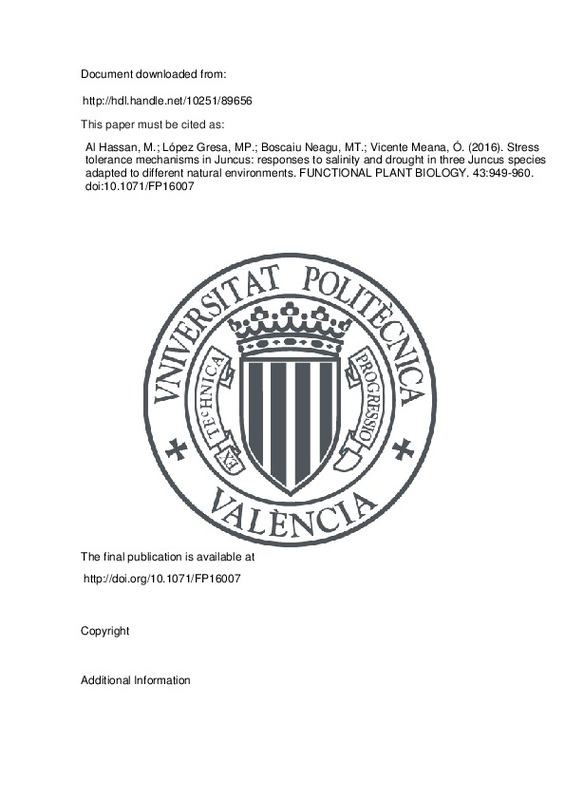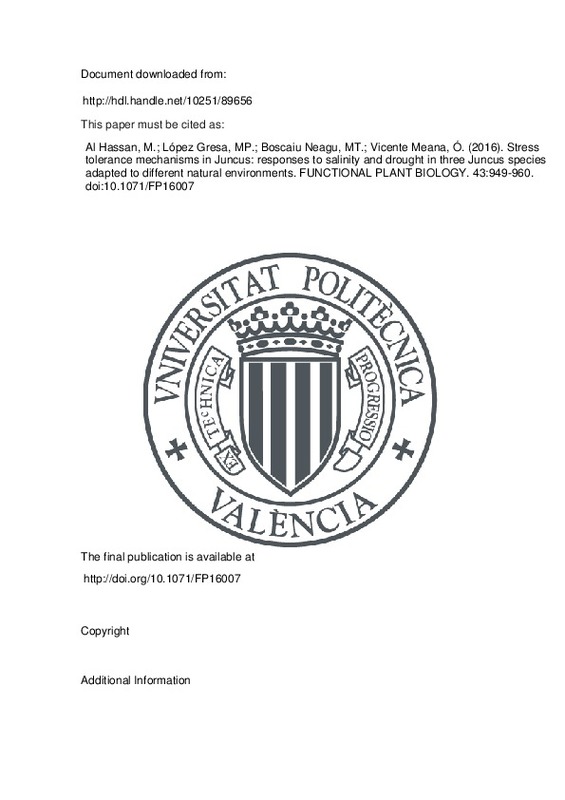Al Hassan, M., Chaura, J., López-Gresa, M. P., Borsai, O., Daniso, E., Donat-Torres, M. P., … Boscaiu, M. (2016). Native-Invasive Plants vs. Halophytes in Mediterranean Salt Marshes: Stress Tolerance Mechanisms in Two Related Species. Frontiers in Plant Science, 7. doi:10.3389/fpls.2016.00473
Albert, R., & Popp, M. (1977). Chemical composition of halophytes from the Neusiedler Lake region in Austria. Oecologia, 27(2), 157-170. doi:10.1007/bf00345820
Ashraf, M., & Foolad, M. R. (2007). Roles of glycine betaine and proline in improving plant abiotic stress resistance. Environmental and Experimental Botany, 59(2), 206-216. doi:10.1016/j.envexpbot.2005.12.006
[+]
Al Hassan, M., Chaura, J., López-Gresa, M. P., Borsai, O., Daniso, E., Donat-Torres, M. P., … Boscaiu, M. (2016). Native-Invasive Plants vs. Halophytes in Mediterranean Salt Marshes: Stress Tolerance Mechanisms in Two Related Species. Frontiers in Plant Science, 7. doi:10.3389/fpls.2016.00473
Albert, R., & Popp, M. (1977). Chemical composition of halophytes from the Neusiedler Lake region in Austria. Oecologia, 27(2), 157-170. doi:10.1007/bf00345820
Ashraf, M., & Foolad, M. R. (2007). Roles of glycine betaine and proline in improving plant abiotic stress resistance. Environmental and Experimental Botany, 59(2), 206-216. doi:10.1016/j.envexpbot.2005.12.006
Bartels, D., & Sunkar, R. (2005). Drought and Salt Tolerance in Plants. Critical Reviews in Plant Sciences, 24(1), 23-58. doi:10.1080/07352680590910410
Bates, L. S., Waldren, R. P., & Teare, I. D. (1973). Rapid determination of free proline for water-stress studies. Plant and Soil, 39(1), 205-207. doi:10.1007/bf00018060
Boscaiu, M., Ballesteros, G., Naranjo, M. A., Vicente, O., & Boira, H. (2011). Responses to salt stress in Juncus acutus and J. maritimus during seed germination and vegetative plant growth. Plant Biosystems - An International Journal Dealing with all Aspects of Plant Biology, 145(4), 770-777. doi:10.1080/11263504.2011.628446
Boscaiu, M., Lull, C., Llinares, J., Vicente, O., & Boira, H. (2012). Proline as a biochemical marker in relation to the ecology of two halophytic Juncus species. Journal of Plant Ecology, 6(2), 177-186. doi:10.1093/jpe/rts017
Bose, J., Rodrigo-Moreno, A., & Shabala, S. (2013). ROS homeostasis in halophytes in the context of salinity stress tolerance. Journal of Experimental Botany, 65(5), 1241-1257. doi:10.1093/jxb/ert430
Boyer, J. S. (1982). Plant Productivity and Environment. Science, 218(4571), 443-448. doi:10.1126/science.218.4571.443
Chen, T. H. H., & Murata, N. (2008). Glycinebetaine: an effective protectant against abiotic stress in plants. Trends in Plant Science, 13(9), 499-505. doi:10.1016/j.tplants.2008.06.007
Clarke, L. D., & Hannon, N. J. (1970). The Mangrove Swamp and Salt Marsh Communities of the Sydney District: III. Plant Growth in Relation to Salinity and Waterlogging. The Journal of Ecology, 58(2), 351. doi:10.2307/2258276
Drabkova, L., Kirschner, J., & Vlcek, C. (2006). Phylogenetic relationships within Luzula DC. and Juncus L. (Juncaceae): A comparison of phylogenetic signals of trnL-trnF intergenic spacer, trnL intron and rbcL plastome sequence data. Cladistics, 22(2), 132-143. doi:10.1111/j.1096-0031.2006.00095.x
DuBois, M., Gilles, K. A., Hamilton, J. K., Rebers, P. A., & Smith, F. (1956). Colorimetric Method for Determination of Sugars and Related Substances. Analytical Chemistry, 28(3), 350-356. doi:10.1021/ac60111a017
Espinar, J. L., Garcia, L. V., & Clemente, L. (2005). Seed storage conditions change the germination pattern of clonal growth plants in Mediterranean salt marshes. American Journal of Botany, 92(7), 1094-1101. doi:10.3732/ajb.92.7.1094
Espinar, J. L., García, L. V., Figuerola, J., Green, A. J., & Clemente, L. (2006). Effects of salinity and ingestion by ducks on germination patterns of Juncus subulatus seeds. Journal of Arid Environments, 66(2), 376-383. doi:10.1016/j.jaridenv.2005.11.001
Fita, A., Rodríguez-Burruezo, A., Boscaiu, M., Prohens, J., & Vicente, O. (2015). Breeding and Domesticating Crops Adapted to Drought and Salinity: A New Paradigm for Increasing Food Production. Frontiers in Plant Science, 6. doi:10.3389/fpls.2015.00978
Flowers, T. J., & Colmer, T. D. (2008). Salinity tolerance in halophytes*. New Phytologist, 179(4), 945-963. doi:10.1111/j.1469-8137.2008.02531.x
Flowers, T. J., Hajibagheri, M. A., & Clipson, N. J. W. (1986). Halophytes. The Quarterly Review of Biology, 61(3), 313-337. doi:10.1086/415032
Flowers, T. J., Munns, R., & Colmer, T. D. (2014). Sodium chloride toxicity and the cellular basis of salt tolerance in halophytes. Annals of Botany, 115(3), 419-431. doi:10.1093/aob/mcu217
Gagneul, D., Aïnouche, A., Duhazé, C., Lugan, R., Larher, F. R., & Bouchereau, A. (2007). A Reassessment of the Function of the So-Called Compatible Solutes in the Halophytic Plumbaginaceae Limonium latifolium. Plant Physiology, 144(3), 1598-1611. doi:10.1104/pp.107.099820
GIL, R., LULL, C., BOSCAIU, M., BAUTISTA, I., LIDÓN, A., & VICENTE, O. (2011). Soluble Carbohydrates as Osmolytes in Several Halophytes from a Mediterranean Salt Marsh. Notulae Botanicae Horti Agrobotanici Cluj-Napoca, 39(2), 09. doi:10.15835/nbha3927176
Gil, R., Boscaiu, M., Lull, C., Bautista, I., Lidón, A., & Vicente, O. (2013). Are soluble carbohydrates ecologically relevant for salt tolerance in halophytes? Functional Plant Biology, 40(9), 805. doi:10.1071/fp12359
Gil, R., Bautista, I., Boscaiu, M., Lidon, A., Wankhade, S., Sanchez, H., … Vicente, O. (2014). Responses of five Mediterranean halophytes to seasonal changes in environmental conditions. AoB PLANTS, 6(0), plu049-plu049. doi:10.1093/aobpla/plu049
Glenn, E. (1999). Salt Tolerance and Crop Potential of Halophytes. Critical Reviews in Plant Sciences, 18(2), 227-255. doi:10.1016/s0735-2689(99)00388-3
GORHAM, J., HUGHES, L., & WYN JONES, R. G. (2006). Chemical composition of salt-marsh plants from Ynys Môn (Anglesey): the concept of physiotypes. Plant, Cell & Environment, 3(5), 309-318. doi:10.1111/1365-3040.ep11581858
Grieve, C. M., & Grattan, S. R. (1983). Rapid assay for determination of water soluble quaternary ammonium compounds. Plant and Soil, 70(2), 303-307. doi:10.1007/bf02374789
Gupta, B., & Huang, B. (2014). Mechanism of Salinity Tolerance in Plants: Physiological, Biochemical, and Molecular Characterization. International Journal of Genomics, 2014, 1-18. doi:10.1155/2014/701596
Hamamoto, S., Horie, T., Hauser, F., Deinlein, U., Schroeder, J. I., & Uozumi, N. (2015). HKT transporters mediate salt stress resistance in plants: from structure and function to the field. Current Opinion in Biotechnology, 32, 113-120. doi:10.1016/j.copbio.2014.11.025
Hariadi, Y., Marandon, K., Tian, Y., Jacobsen, S.-E., & Shabala, S. (2010). Ionic and osmotic relations in quinoa (Chenopodium quinoa Willd.) plants grown at various salinity levels. Journal of Experimental Botany, 62(1), 185-193. doi:10.1093/jxb/erq257
Jones, E., Simpson, D., Hodkinson, T., Chase, M., & Parnell, J. (2007). The Juncaceae-Cyperaceae Interface: A Combined Plastid Sequence Analysis. Aliso, 23(1), 55-61. doi:10.5642/aliso.20072301.07
Kumari, A., Das, P., Parida, A. K., & Agarwal, P. K. (2015). Proteomics, metabolomics, and ionomics perspectives of salinity tolerance in halophytes. Frontiers in Plant Science, 6. doi:10.3389/fpls.2015.00537
Munns, R., & Termaat, A. (1986). Whole-Plant Responses to Salinity. Functional Plant Biology, 13(1), 143. doi:10.1071/pp9860143
Munns, R., & Tester, M. (2008). Mechanisms of Salinity Tolerance. Annual Review of Plant Biology, 59(1), 651-681. doi:10.1146/annurev.arplant.59.032607.092911
Naidoo, G., & Kift, J. (2006). Responses of the saltmarsh rush Juncus kraussii to salinity and waterlogging. Aquatic Botany, 84(3), 217-225. doi:10.1016/j.aquabot.2005.10.002
Niu, X., Bressan, R. A., Hasegawa, P. M., & Pardo, J. M. (1995). Ion Homeostasis in NaCl Stress Environments. Plant Physiology, 109(3), 735-742. doi:10.1104/pp.109.3.735
Ozgur, R., Uzilday, B., Sekmen, A. H., & Turkan, I. (2013). Reactive oxygen species regulation and antioxidant defence in halophytes. Functional Plant Biology, 40(9), 832. doi:10.1071/fp12389
Pang, Q., Chen, S., Dai, S., Chen, Y., Wang, Y., & Yan, X. (2010). Comparative Proteomics of Salt Tolerance inArabidopsis thalianaandThellungiella halophila. Journal of Proteome Research, 9(5), 2584-2599. doi:10.1021/pr100034f
Partridge, T. R., & Wilson, J. B. (1987). Salt tolerance of salt marsh plants of Otago, New Zealand. New Zealand Journal of Botany, 25(4), 559-566. doi:10.1080/0028825x.1987.10410086
RAVEN, J. A. (1985). TANSLEY REVIEW No. 2. REGULATION OF PH AND GENERATION OF OSMOLARITY IN VASCULAR PLANTS: A COST-BENEFIT ANALYSIS IN RELATION TO EFFICIENCY OF USE OF ENERGY, NITROGEN AND WATER. New Phytologist, 101(1), 25-77. doi:10.1111/j.1469-8137.1985.tb02816.x
Rodrı́guez-Navarro, A. (2000). Potassium transport in fungi and plants. Biochimica et Biophysica Acta (BBA) - Reviews on Biomembranes, 1469(1), 1-30. doi:10.1016/s0304-4157(99)00013-1
Rozema, J. (1976). An Ecophysiological Study on the Response to Salt of Four Halophytic and Glycophytic Juncus Species. Flora, 165(2), 197-209. doi:10.1016/s0367-2530(17)31845-5
Rozema, J. (1991). Growth, water and ion relationships of halophytic monocotyledonae and dicotyledonae; a unified concept. Aquatic Botany, 39(1-2), 17-33. doi:10.1016/0304-3770(91)90019-2
Smirnoff, N., & Cumbes, Q. J. (1989). Hydroxyl radical scavenging activity of compatible solutes. Phytochemistry, 28(4), 1057-1060. doi:10.1016/0031-9422(89)80182-7
Szabados, L., & Savouré, A. (2010). Proline: a multifunctional amino acid. Trends in Plant Science, 15(2), 89-97. doi:10.1016/j.tplants.2009.11.009
Vicente, M. J., Conesa, E., Álvarez-Rogel, J., Franco, J. A., & Martínez-Sánchez, J. J. (2007). Effects of various salts on the germination of three perennial salt marsh species. Aquatic Botany, 87(2), 167-170. doi:10.1016/j.aquabot.2007.04.004
Vinocur, B., & Altman, A. (2005). Recent advances in engineering plant tolerance to abiotic stress: achievements and limitations. Current Opinion in Biotechnology, 16(2), 123-132. doi:10.1016/j.copbio.2005.02.001
Watson, E. B., & Byrne, R. (2009). Abundance and diversity of tidal marsh plants along the salinity gradient of the San Francisco Estuary: implications for global change ecology. Plant Ecology, 205(1), 113-128. doi:10.1007/s11258-009-9602-7
Weimberg, R. (1987). Solute adjustments in leaves of two species of wheat at two different stages of growth in response to salinity. Physiologia Plantarum, 70(3), 381-388. doi:10.1111/j.1399-3054.1987.tb02832.x
Zhu, J.-K. (2001). Plant salt tolerance. Trends in Plant Science, 6(2), 66-71. doi:10.1016/s1360-1385(00)01838-0
[-]








![[Cerrado]](/themes/UPV/images/candado.png)


